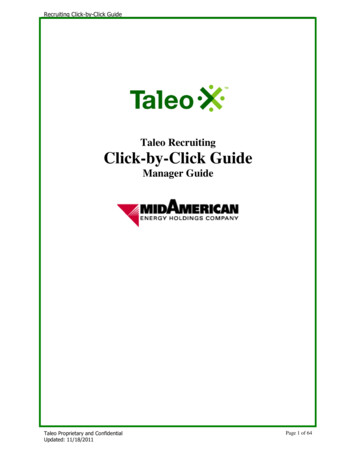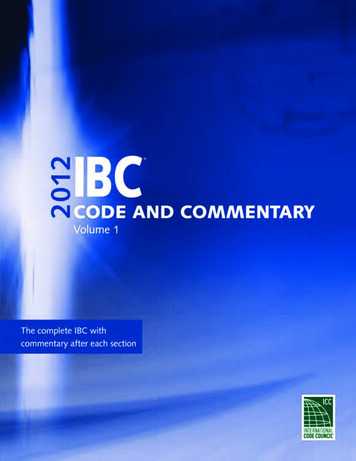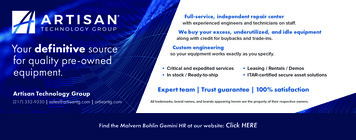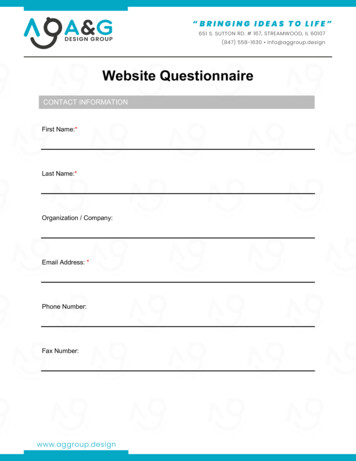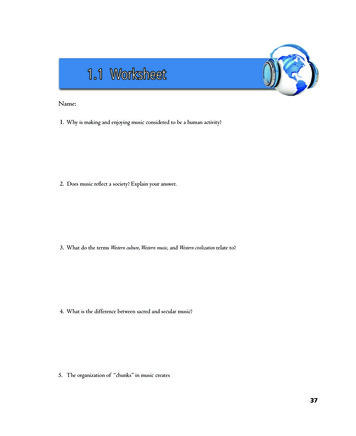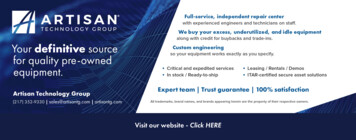
Transcription
- ARTISAN ITECHNOLOGY GROUPFull-service, independent repair centerwith experienced engineers and technicians on staff.We buy your excess, underutilized, and idle equipmentalong with credit for buybacks and trade-ins.Your definitive sourcefor quality pre-ownedequipment.Artisan Technology Group(217) 352-9330 sales@artisantg.com artisantg.comCustom engineeringso your equipment works exactly as you specify. Critical and expedited services Leasing / Rentals/ Demos In stock/ Ready-to-ship !TAR-certified secure asset solutionsExpert teamI Trust guarantee I 100% satisfactionA ll trade marks, brand names, and brands appearing he rein are the pro perty of their respective owne rs.Visit our website - Click HERE
MIL-STD-1553 Tutorial and ReferencePart Number: 10010-00000-A4Cage Code: 4RK27 NAICS: 334118Alta Data Technologies LLC4901 Rockaway Blvd., Building ARio Rancho, NM 87124 USA(tel) 505-994-3111 www.altadt.comiMIL-STD-1553 Tutorial and Reference 10011-00000-A4Artisan Technology Group - QualityInstrumentationGuaranteed (888) 88-SOURCE www.artisantg.comAlta DataTechnologies.LLC www.altadt.com
CUSTOMER NOTES:Revision Control HistoryRev A4Release 4 January 2018This is not a QMS Controlled Document.Note to the Reader and End-User:This document is provided for information only and is copyrighted 2007-2014 by Alta Data TechnologiesLCC. While Alta strives to provide the most accurate information, there may be errors and omissions inthis document. Alta disclaims all liability in document errors and any product usage. By using an Altaproduct, the customer or end user agrees (1) to accept Alta’s Standard Terms and Conditions of Sale,Standard Warranty and Software License and (2) to not hold Alta Members, Employees, Contractors orSales & Support Representatives responsible for any loss or legal liability, tangible or intangible, from anydocument errors or any product usage.The product described in this document is not US ITAR controlled. Use of Alta products ordocumentation in violation of local usage, waste discard and export control rules, or in violation of USITAR regulations, voids product warranty and shall not be supported. This document may be distributedto support government programs and projects. Third party person, company or consultant distribution isnot allowed without Alta’s written permission.AltaCore, AltaCore-1553, AltaCore-ARINC, AltaAPI, AltaView and AltaRTVal are Trademarks of AltaData Technologies LLC, Rio Rancho, New Mexico USAContact:We welcome comments and suggestions. Please contact us at 888-429-1553 (toll free in US) or 505994-3111 or visit our web site for support submit forms at www.altadt.com or email us atalta.info@altadt.com or alta.support@altadt.com.iiMIL-STD-1553 Tutorial and Reference 10011-00000-A4Artisan Technology Group - QualityInstrumentationGuaranteed (888) 88-SOURCE www.artisantg.comAlta DataTechnologies.LLC www.altadt.com
Table of Contents1553 Tutorial and Reference . 1Figure: 1553 Example Single Bus with Two Remote Terminals and One Monitor . 2A Brief History of Digital Data Busses and History of MIL-STD-1553 . 21553 Basics. 31553A and 1553B Variants . 31553 Communication Basics . 31553 Layer One: Physical Layer. . 4Wire, Couplers, Terminators and Bit Encoding . 4Figure: 1553B Bus Components . 5Terminology Review: . 5 Bus: . 5 Coupler: . 5 Stub: . 6 Terminator: . 61553 Signal Encoding . 6Bus Problems and Troubleshooting . 71553 Troubleshooting Tips . 7Layer Two – Data Link Layer: Word and Message Protocols. 71553 Command Words . 81553 Hex Displays . 9Figure: 1553B Mode Code Table . 101553 Data Words . 101553 Status Word . 111553B Message Types and Structures . 11BC-RT Messages (Normal and Mode Code With and Without Data Word) . 13RT-BC Messages (Normal and Mode Code with Data Word) . 14RT-RT Messages (Normal and Broadcast) . 14BC-RT(s) Broadcast Messages (Normal and Mode Code) . 15Integration Issues for BC, RT and Monitor Computers . 17iiiMIL-STD-1553 Tutorial and Reference 10011-00000-A4Artisan Technology Group - QualityInstrumentationGuaranteed (888) 88-SOURCE www.artisantg.comAlta DataTechnologies.LLC www.altadt.com
Application Discussions. 17BC Review – Application Designs . 17Figure: Example BC Message and Framing Options . 18RT Review – Application Designs . 191553 Application Review – Polling or Interrupts . 19Revision Information. 20ivMIL-STD-1553 Tutorial and Reference 10011-00000-A4Artisan Technology Group - QualityInstrumentationGuaranteed (888) 88-SOURCE www.artisantg.comAlta DataTechnologies.LLC www.altadt.com
1553 Tutorial and ReferenceMIL-STD-1553 (1553) is a standard that describes a one-megabit serial networkphysical layer (layer one: physical layer – PHY) and message level protocol (layer two:data link layer). Primarily used in legacy avionics, power, sensor and control systems,1553 has been deployed on thousands of applications worldwide throughout its 35 year existence including prototype passenger cars, oil platforms, subway controlsystems and the International Space Station. The US DoD gave-up oversight of thestandard (and most MIL-STD documents) in the early 1990s and the standard is nowoverseen by the Society of Automotive Engineers (SAE) as commercial document“AS15531.”This overview is designed to complement the referenced MIL-HDBK-1553A document,which provides an excellent detailed review of the 1553 standard (MIL-HDBK-1553ASection 20 provides a summary of MIL-STD-1553B Notice 2). Commercially availablechip-sets and network interface cards (like Alta’s) “off load” the protocol processing(protocol engine) so the engineer’s primary concern is the design and integration ofapplication software (data packet transfers) and cabling issues. For example, Altaproducts and API software off load the 1553 protocol overhead in the same way anEthernet network interface card (NIC) and operating system drivers offload EthernetTCP/UDP/IP transfer protocols; this allow the customer/engineer to concentrate on dataprocessing at the required frequencies of the application (and not worry about the 1553transfer protocols).The following paragraphs will highlight the main points of the standard that the design orsystem engineer needs to know for a successful integration.NOTE: When referencing the MIL-HDBK-1553A and MIL-STD-1553 documentspay particular close attention to “legal/illegal” and “required” message types andthe required support “bits” of an RT Status Word. There are minimumimplementation requirements to be a compliant 1553B terminal and the designershould reference this information from the standard.The following diagram shows a crude example of a simple network with computers (BC,RTs and/or Monitor), bus cabling, transformer couplers, stub cables and busterminators. More description on these terms is provided in the following sections. The1MIL-STD-1553 Tutorial and Reference 10011-00000-A4Artisan Technology Group - QualityInstrumentationGuaranteed (888) 88-SOURCE www.artisantg.comAlta DataTechnologies.LLC www.altadt.com
computers shown in the picture could be actual Line Replacement Units (LRUs) or aPC/VME computer with an Alta 1553 interface card.Figure: 1553 Example Single Bus with Two Remote Terminals and One Monitor(Not to Scale)A Brief History of Digital Data Busses and History of MILSTD-1553Before diving deeper in the review, let’s have a brief history lesson Erwin Gangl wasone of the early pioneers in integrating digital computers into military aircraft whileworking as an electrical engineer at Dayton’s Wright-Patterson Air Force Base from1965 to 1988. In the late 1960s he was assigned to handle the digital computerrequirements in the F-15 program office. (Ref1)“With that came the requirement to set up the inter-communication with all of the otheravionic subsystems like the radar navigation controls and displays,” said Gangl, who’sconsidered by many to be the father of the data bus standard (Mil-Std-1553) that led toplug-and-play digital avionics. “Where in the past all signals were connected by stringingpoint-to-point wires, resulting in big cables and connectors, it became very frustrating tome that this couldn’t be done digitally. So I recommended that we go to a timeshareddigital multiplex data bus concept. The digital conversion is done at the sensor, and adigital signal is sent to the computer via a dual redundant shielded twisted wire pair.This replaced having to have the analog-to-digital converter hardware being part of thecomputer, and also reduced the number of wire cables needed to connect the computerto the rest of the avionics. It turned out that the concept was accepted, and wedeveloped the Mil-Std-1553 data bus standard that is still in use today.” (Ref1)2MIL-STD-1553 Tutorial and Reference 10011-00000-A4Artisan Technology Group - QualityInstrumentationGuaranteed (888) 88-SOURCE www.artisantg.comAlta DataTechnologies.LLC www.altadt.com
Today, 1553 is regarded as a low speed computer network standard that can bedeveloped with readily available commercial components and is ideal forenvironmentally harsh environments (especially environments with electrical noise).(Ref1 IEEE-USA yrs.htm)1553 BasicsA 1553 network (or “data bus” in older terms) is a heterogeneous architecture wherethe various computers (terminals) on the network have a master/slave relationship.Message communication is controlled by one master terminal/computer called the BusController (BC). The BC initiates all communications between computer-network endpoints, which are called Remote Terminals (RTs). There can also be passive Monitorterminals (“Bus Monitor – BM”) that “sniff” or record bus traffic (message packets).The standard does not describe anything about application processes beyond the layertwo data link protocol, so it is completely up to the system designer to architect themessage frequencies and physical bus patterns. Since the 1553 topology consists ofone central BC computer initiating all communications, very deterministic messagetiming (to the tens of microseconds, but usually 100s/1000s of microseconds) can beachieved.1553A and 1553B VariantsThere have been two main variants of 1553, the “A” version (1553A) and the current “B”(1553B) version. The differences between the two are minor, but important and all newsystems (from about 1980) should be using 1553B. Some older aircraft (pre 1985) have1553A or mixed RT terminals so watch out for these systems. The Alta productssupport both 1553A and B. “Notice II” for 1553B was released in 1988 and is thecurrent document that most systems reference (including this discussion).1553 Communication BasicsA 1553 network is time division, half duplex communications where all transmissionsare on a single cable (unlike full-duplex Ethernet, RS-232/422 or ARINC-429 whereseparate transmit and receive wires are utilized). Only one computer terminal cantalk/transmit at any given time (time division) and the other computers listen/receive (fullduplex systems like Ethernet and RS-232 allow simultaneous transmit and receive ondifferent wires).For safety critical systems, there are one or more standby redundant busses (networks)that are strictly for back-up communications. A common term for a 1553 network is “dualredundant bus,” which means there are two independent bus networks (one bus iscalled the Primary or “A” bus and the other is the Secondary or “B” bus). 1553messages (data) is usually only transmitted on one of the A or B bus networks at a time,3MIL-STD-1553 Tutorial and Reference 10011-00000-A4Artisan Technology Group - QualityInstrumentationGuaranteed (888) 88-SOURCE www.artisantg.comAlta DataTechnologies.LLC www.altadt.com
but it doesn’t usually matter which bus is used for the message transfers (computers ona 1553 network are supposed to handle messages on either the A or B bus with equalpriority). In more safety critical implementations, there may be complete redundant A/Bnetwork systems (message priority handling is unique for each system with thisconfiguration).A simple 1553 network example may have one central computer (BC) and one or moreremote computers (Remote Terminals or “RTs”). With more complex systems, theremay be several 1553 networks, each one with a single BC and several RTs (up to 31RTs) to control applications such as flight controls, sensor/power/motor controls, enginemanagement and/or stores management.The BC is usually the main system computer and often has common names such asflight control computer (FCC) or mission control computer (MCC), etc. In these multiplenetwork scenarios, a BC of one network might be an RT of another network (and thusprovide a bridge or gateway between the 1553 networks). In more modern systems, a1553 network may be a legacy connection to older computers (RTs) that are not in needof redesign (or can’t be redesigned due to cost, which it most often the case). Modernsystems will often have other networks (e.g. RS-485, ARINC-429, Ethernet/AFDX,Fibrechannel or Firewire) for high rate data transfers between one or more computers.A Bus Monitor (BM) is simply a network message sniffer or recorder. In olderelectronics, this function was actually quite complicated and this dedicated function wasbroken out to separate computers or electronic assemblies. Today, BM capability isoften integrated directly in the same chip or interface card (like Alta’s cards or Ethernetconverter type devices) that performs BC or RT functions.1553 Layer One: Physical Layer.Wire, Couplers, Terminators and Bit EncodingThe first thing to know about a 1553 network is how to physically build one bus/network.99% of 1553 problems (besides getting the software loaded!) are from incorrectlyconstructed busses or broken bus components. A 1553 bus must be constructed as a78-ohm balanced topology and it is strongly recommended that transformer coupling beused (“direct coupling” uses T connectors and is only allowed on very old 1553Asystems). Notice 2 of MIL-STD-1553 states that direct coupling should be avoided andstates that only transformer coupling shall be used for US Army and Air Force systems– see section 30.10.5. The following figure shows a properly constructed bus and itscomponents.4MIL-STD-1553 Tutorial and Reference 10011-00000-A4Artisan Technology Group - QualityInstrumentationGuaranteed (888) 88-SOURCE www.artisantg.comAlta DataTechnologies.LLC www.altadt.com
Figure: 1553B Bus ComponentsTerminology Review: Bus: The cable between couplers. Technically this can be any length, but therecommended length between couplers is 18 inches (this reduces reflections).The 1553B standard does not specify a maximum length because the generalthought was 1553B would go Fiber Optic by the mid 1980s. This was a mistakefor wired networks. The 1553A standard referenced a maximum length of 100meters and this should also be followed for 1553B systems. Coupler: Transformer interconnect from the bus to the stub of a BC, RT orMonitor. The transformer ratios are a step down from the stub to the bus with aratio of 1.41. (There is also a 1:1 transformer inside the BC, RT or Monitorcomputer to isolate internal shorts to the bus). The 1553A standard also allowsfor “direct” or T connector coupling, which was used on older F-18 systems, butdirect coupling is NOT recommended (and shall not be used on US Army andAir Force systems – See Notice 2 section 30.10.5).o There are multi-stub couplers, which simply mean there are multiple singlestub connections in the same box. Don’t get confused and use a multistub coupler to connect the one computer to both the primary (A) orsecondary (B) redundant bus. Multi-stub couplers allow multiplecomputers to be connected to the SAME bus.5MIL-STD-1553 Tutorial and Reference 10011-00000-A4Artisan Technology Group - QualityInstrumentationGuaranteed (888) 88-SOURCE www.artisantg.comAlta DataTechnologies.LLC www.altadt.com
Figure: Multi-Stub Coupler Example - Two Stub and Eight Stub Coupler Stub: The cable between the transformer and the BC, RT or Monitor. Themaximum length of the stub cable is 20ft for a transformer-coupled bus.Recommended lengths are 18 inches to 18 ft. Remember that the total stublength includes backplane and PCB trace lengths to the required isolationtransfer inside the BC, RT or Monitor (see the standard for more details – most1553 chip manufactures provide the proper reference drawings for the circuitcard design). Many people try to have stub lengths longer than 20ft and thisusually causes problems. Try not to exceed 18ft (this gives a bit of leeway inyour design). If you do use direct coupling, your stubs must not exceed 1 foot(12 inches). Terminator: 78 Ohm End Cap at the end of the bus cable or last coupler onBOTH sides of the bus. Do NOT put terminators on stub connections – this putsa significant load on the bus.1553 Signal Encoding1553 uses Manchester II Bi-Phase (Non-Return to Zero, NRZ) encoding for bits. Thefollowing figure shows this format for a bit time. When the bus is idle (no transmission),the bus signal should be at ground. Please see the MIL-HDBK-1553A document fordetails on bus signaling, levels and testing/measurements. The bit rate for 1553 is onemega bit, but the bi-phase e
MIL-STD-1553 Tutorial and Reference 10011-00000-A4 Alta Data Technologies LLC www.altadt.com 1 1553 Tutorial and Reference MIL-STD-1553 (1553) is a standard that describes a one-megabit serial network physical layer (layer one: physical layer

